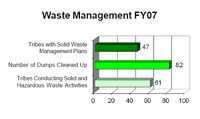Pacific Southwest, Region 9
Serving: Arizona, California, Hawaii, Nevada, Pacific Islands, 148 Tribes
Protecting Tribal Lands
Protecting Tribal Lands
Tribes Use Innovative Tactics to Clean Up Waste, Hazardous Materials

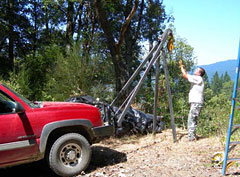
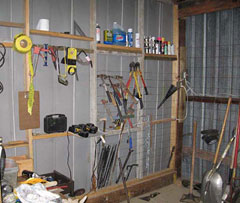
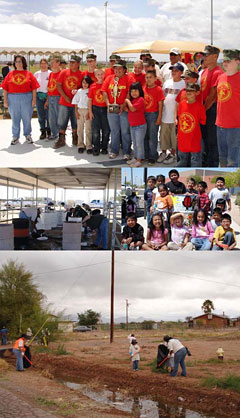
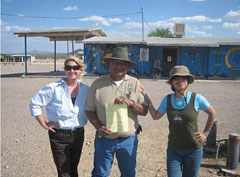


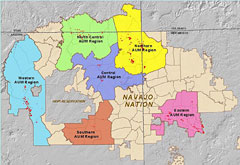
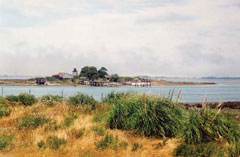
Improper disposal of both household trash and hazardous waste threaten tribal lands in the Pacific Southwest. More than 1,200 open dumps, dozens of abandoned storage tanks, and hundreds of abandoned mine sites litter these tribal lands.
Tribes Work with EPA to Clean Up Open Dumps and Expand Recycling Programs
In 2007, tribes tackled these hazards by cleaning up 82 open dumps, and collecting household hazardous waste. They developed recycling and composting programs, and removed and recycled abandoned vehicles.
Collaboration Closes Open Dumps
The Torres Martinez Solid Waste Collaborative got impressive results this year. The collaborative, which includes representatives from EPA and 24 other federal, state, and local agencies, the Torres Martinez Desert Cahuilla Indians, and nonprofit organizations, closed 20 of 27 known dumps, put access controls in place, and prevented new dumps from being started on the Torres Martinez Reservation in Southern California's Coachella Valley.
Their efforts have also cut dump fires by more than 70%. Together, collaborative members distributed information on proper waste disposal to more than 500 local growers, haulers, and landscapers to reduce waste coming onto tribal lands.
The collaborative used new regulatory authority to conduct solid waste inspections in 2006. Those led to four enforcement actions in 2007 and two legal settlements with penalties of $12,525 and a supplemental environmental project.
Tribal Innovation Removes 44 Tons of Waste
The Hoopa Valley Tribe conducted four dump cleanups using an innovation of the tribe, the "Blake Apparatus." The innovation, which saved the tribe as much as $10,000 in contractor fees, operates from the front end of a pickup truck with a winch-powered cableway and allows the operator to remove waste from steep terrain. One person can operate the Blake Apparatus, which fits in the back of any pickup truck and sets up in less than 10 minutes. The apparatus, which won a 2007 EPA award, enabled the four-person staff of the Hoopa Tribal Environmental Protection Agency to remove 44 tons of trash, appliances, and scrap metal.
Tribe Transforms Trash
The Pinoleville Pomo Nation's Environmental Department has found new uses for abandoned trailers by using parts of the dismantled trailers to build a tool shed. Other plans for similar trash reuse projects include building a fence out of abandoned tires and a greenhouse made of abandoned trailer trusses.
"Project Can It" Collects 2 Tons of Waste in 2 Days
In Arizona, the Salt River Pima-Maricopa Indian Community held a free community tire cleanup that removed and recycled 2,500 tires in 2007. That brings the total removed since 2005 to more than 7,000.
The tribe also organized "Project Can It," a community cleanup and recycling effort. It featured recycled 55- gallon drums as drop-off points and a competition among 12 teams to see who could collect the most waste. The teams collected more than two tons of waste in two days.
Solid Waste, Recycling Service Reduces Open Dumping and Burning

The Pit River Tribe developed a solid waste and recycling collection program for their tribal homes and businesses. With EPA and USDA grant funding, the tribe hired a solid waste coordinator and technician, purchased a collection vehicle and bins, and established the Pit River Solid Waste and Recycling service. The service includes a drop-off recycling center, a car crushing operation, and a "pay-as-you-throw" trash collection program. The Pit River Tribe also found a way to generate additional income for the program by renting out their collection vehicle and clean-up bins.
The Washoe Tribe of Nevada and California worked on a number of successful solid waste projects in 2007. These included the startup of a backyard composting program and the development of a draft solid waste code to more effectively control illegal dumping. The tribe also began purchasing paper that contains at least 30% post consumer recycled content for all tribal offices.
Tribes Work with EPA to Close Underground Storage Tanks Leaking Fuel
In 2007, tribes and EPA inspected 96 underground storage tanks, issued 25 field citations, and conducted four UST inspector trainings with over 300 tribal participants. To date, 17 underground storage tanks have been cleaned up with federal funding on tribal land.
Along the Klamath River near California’s northern border, EPA has been working with the Yurok Tribe to review the tribe’s progress on completing a Leaking Underground Storage Tank site inventory. The tribe received a $30,000 EPA grant to fund their work.
The Tohono O'odham Nation's Environmental Program Office and its Hickiwan District have been working cooperatively with EPA to permanently close underground storage tanks at the Vaya Chin site. These tanks had been unused for several years. Under the district's leadership the tribe was able to get funding for the removal of these old tanks. The site may now be used for new economic development.
Along the Lower Colorado River, where California borders Arizona, EPA has been working with the Colorado River Indian Tribe and contractors to remove and clean up leaking underground tanks at Telles Ranch, which is next to the river. According to a site assessment done in September 2007, leaking tanks have polluted both soil and groundwater. EPA is now evaluating cleanup alternatives.
Superfund Helps Tribes Remove Contamination from Former Mines
EPA's Superfund Division works closely with tribes to clean up tribal lands contaminated by mining and other activities. Several abandoned mines located on tribal lands are on the Superfund National Priorities List (NPL). Those sites are environmental threats due to acids and dissolved metals that have polluted surface water and groundwater. Along with the mining cleanup projects, EPA provided more than $3.2 million in grants to tribes in 2007 to investigate, clean up, and restore tribal lands to beneficial uses.
$7.5 Million Project Cleans Up Mercury, Arsenic, Protects Cultural Resources
The 150-acre Sulphur Bank Mercury Mine, next to Clear Lake and the Elem Indian Colony, was once one of the state's largest producers of mercury. EPA put it on the NPL in 1990. In December 2006, EPA finished a $7.5 million project at the Elem Colony to remove mine wastes with mercury and arsenic from beneath and around homes. EPA removed 28,000 cubic yards of mine wastes, installed five new modular homes, and refurbished and cleaned seven existing homes. EPA also replaced two trailers and rebuilt the paved roadway system with new curbs, storm drains, and sidewalks. Finally, EPA replaced the water supply system, and improved the sewers.
EPA collaborated with the tribe to complete the cleanup while protecting cultural resources. Tribal members helped identify and preserve cultural artifacts in and around the cleanup area. Nearly one third of the construction crew were tribal members. As part of the project, nine tribal members also received 40-hour Hazardous Materials training.
Biological Treatment System Cleans 5,000,000 Gallons of Acid a Year
The Leviathan Mine, an abandoned open-pit sulfur mine in Alpine County, California, has contaminated a nine-mile stretch of mountain creeks. Some of the polluted areas are stretches that run through Washoe Tribal lands. The tribe is working to help protect traditional uses of area resources. The mine's lime treatment plant treated nearly six million gallons of acid mine drainage in 2007. A biological system operates all year and has treated more than five million gallons this year.
Navajo Nation and EPA Investigate Cold War Era Uranium
In Arizona, New Mexico and Utah, mining and milling of uranium ore for nuclear weapons took place at hundreds of sites on the Navajo Nation during the Cold War. These activities dispersed radiation and heavy metals in soil and water, causing health concerns among Navajo residents. The Navajo Nation and EPA recently completed a $13 million investigation of these abandoned sites. The work involved aerial surveying of 41 mining areas totaling about 1,440 square miles, water sampling at 226 locations, surveying 28 homes for radiation, and 34 radiation screening surveys. Researchers merged data from the Navajo Nation EPA, the U.S. Geological Survey, the Bureau of Indian Affairs, the Department of Energy, and the states of Arizona, Utah, and New Mexico to identify more than 500 mine sites. The results are being shared with Navajo officials and communities, regulators, health agencies, universities and nonprofits. The results will help Navajo Nation EPA and EPA prioritize response work. The study was also used to publicize the mine locations and to help the Navajo Nation identify and reduce radiation risks.
Tribes Revitalizing Contaminated Lands
In 2007, EPA provided grants to the Navajo Nation, Gila River Indian Community, Tohono O'odham Nation and Yurok Tribe to establish and enhance their Brownfields cleanup and response programs. The Navajo Nation used this funding to develop their own Superfund legislation that gives the tribe authority to conduct and oversee cleanups on Navajo land.
The Wiyot Tribe, located at the Table Bluff Reservation on California's North Coast, used an EPA Brownfields grant to clean up contaminated boat repair facilities at Indian Island in Humboldt Bay. The 1.5-acre shell mound site is also known as the tribe's Tuluwat Village, and will be restored as a sacred tribal gathering place and dance grounds.
At the Salt River Pima Maricopa Indian Community near Phoenix, Arizona, EPA Brownfields assessment and cleanup grants are helping the tribe revitalize a 160-acre former cattle feedlot site that is contaminated with pesticides. Funds will be used to clean up biological waste and pesticides. The tribe plans to use the site for agricultural development that will provide jobs in the community.
| Pacific Southwest NewsroomPacific Southwest Programs | Grants & FundingUS-Mexico Border | Media Center Careers | About EPA Region 9 (Pacific Southwest)A-Z Index |

